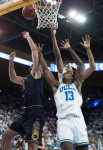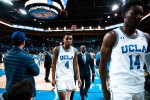At the 13:16 mark of the first half, the Bruins boasted an eight-point lead.
The Bearcats bounced back – and then some.
In its first true road game of the season, UCLA men’s basketball (7-4) lost 93-64 to Cincinnati (10-2) on Wednesday night. The Bearcats responded to the Bruins’ fast start by putting together a 28-4 run of their own, burying the Bruins in their worst lost since Dec. 20, 2014 against Kentucky.
This is UCLA’s second straight loss – the second time this season that the Bruins have lost back-to-back games.
The Bearcats outrebounded the Bruins by 13, outscored them by eight in the paint, and outshot them by 12 percent from the field and 22.5 percent from 3-point range.
UCLA started 7-of-11 from the field, but went 3-of-14 to close out the first half. Sophomore guard Kris Wilkes had 12 points in the first frame, while the rest of the Bruins combined for 19.
Wilkes finished the game with a team-high 21 points.
Heading into halftime, the Bearcats built a 48-31 lead in their second-best offensive half of the season. The only time this year that Cincinnati scored more than 48 points in the first half was against Arkansas-Pine Bluff on Nov. 27.
The Bearcats’ 93 points were also the second-most the Bruins have allowed all season, and the 29-point lead Cincinnati held was the largest deficit UCLA has seen this year.
Sophomore guard Jaylen Hands dished out a season-high 12 assists, but he went 1-of-5 from the field, with all of his field goal attempts coming from behind the arc.
Freshman center Moses Brown scored two points on 1-of-2 shooting in the first period, but ended the game with 12 points and six rebounds. Redshirt freshman Cody Riley started on the other block and notched an 11-point, 10-rebound double-double.
UCLA will head to Chicago to take on No. 15 Ohio State on Saturday in the CBS Sports Classic.







